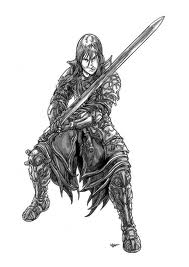I started this month with a new Archetype and a new Class, both based on the famous Swashbuckler concept. I thought about be ending the month then with more light-armored warriors for Pathfinder. This time, I sought a more traditional approach – 2 new Archetypes that rely on agility instead of armor; one for the Fighter, the other for the Rogue (I know that there’s already a Swashbuckler archetype for him, but I find it terrible).
Swashbuckler (Fighter Archetype)
New Skills: Acrobatics, Appraise, Bluff, Diplomacy, Knowledge (Local). Lose Knowledge (Engineering).
Skill Points per Level: 4 + Int.
Good Fortitude and Reflex saves. Lose Armor Training 3 and Armor Mastery.
Weapon and Armor Proficiency: Light Armors, Light Shields and Buckler. Simple Weapons, Light and One-Handed Martial Weapons, Whips and Shortbows.
Finesse Style (Ex): At 1st level, a Swashbuckler gains the benefits of the Weapon Finesse feat when attacking with a light blade weapon or a whip. If fighting defensively with these weapons he only suffers a –2 penalty. This ability replaces the Fighter’s 1st bonus feat.
Nimble (Ex): At 2nd level, a Swashbuckler gains a +1 dodge bonus to AC while wearing light or no armor. Anything that causes the Swashbuckler to lose her Dexterity bonus to AC also causes him to lose this dodge bonus. This bonus increases by +1 for every four levels beyond 2nd level.
This ability replaces Bravery.
Parry (Ex): At 3rd level, when a Swashbuckler makes a full attack with a light blade weapon or whip, he gains a +1 bonus to AC against melee attacks until the beginning of his next turn. This bonus increases by +1 every four levels after 3rd.
This ability replaces Armor Training 1 and 4.
Fencing (Ex): At 4th level, when a Swashbuckler makes a full attack with a light blade weapon or whip, he can add his Dexterity bonus to his damage rolls.
This ability replaces Weapon Training 1 and 4.
Light Armor Mastery (Ex): At 7th level a Swashbuckler learns to be more maneuverable while wearing light armor. Whenever he is wearing armor, he reduces the armor check penalty by 2 (to a minimum of 0) and increases the maximum Dexterity bonus allowed by his armor by 2. At 11th level, these bonuses increase –4 reduction of the armor check penalty and a +4 increase of the maximum Dexterity bonus allowed.
This ability replaces Armor Training 2.
Uncanny Dodge (Ex): At 6th level a Swashbuckler gains Uncanny Dodge. This replaces the 6th level’s Bonus Feat. At 9th level a Swashbuckler gains Improved Uncanny Dodge. This replaces Weapon Training 2.
Repartee (Ex): At 13th level a Swashbuckler using a light blade weapon or whip can make an attack of opportunity as an immediate action against an opponent whiting reach who failed to hit him.
This ability replaces Weapon Training 3.
Weapon Stride (Ex): At 20th level, a Swashbuckler can make a full attack as a standard action while wearing light or no armor.
This ability replaces Weapon Mastery.
Fencer (Rogue Archetype)
Skill Points per Level: 6 + Int.
Armor and Weapon Proficiency: Add Whips, Light Shields and Bucklers.
Fencing Style (Ex): At 1st level, a Fencer gains Weapon Finesse and Defensive Combat Training. These feats only work if the Fencer is wearing light armor or no armor.
This ability replaces Trapfinding.
Nimble (Ex): At 3rd level, a Fencer gains a +1 dodge bonus to AC while wearing light or no armor. Anything that causes the Fencer to lose her Dexterity bonus to AC also causes him to lose this dodge bonus. This bonus increases by +1 for every four levels beyond 2nd level (to a maximum of +5 at 20th level).
This ability replaces Trap Sense.
Flashing Blade (Ex): When a Fencer makes a full attack with a weapon eligible for the Weapon Finesse feat he gains a +1 bonus to all his attack rolls. This bonus increases by +2 at 5th level, +3 at 9th, +4 at 13th and +5 at 17th.
This ability replaces the rogue talents of the 6th, 12th and 20th level.













